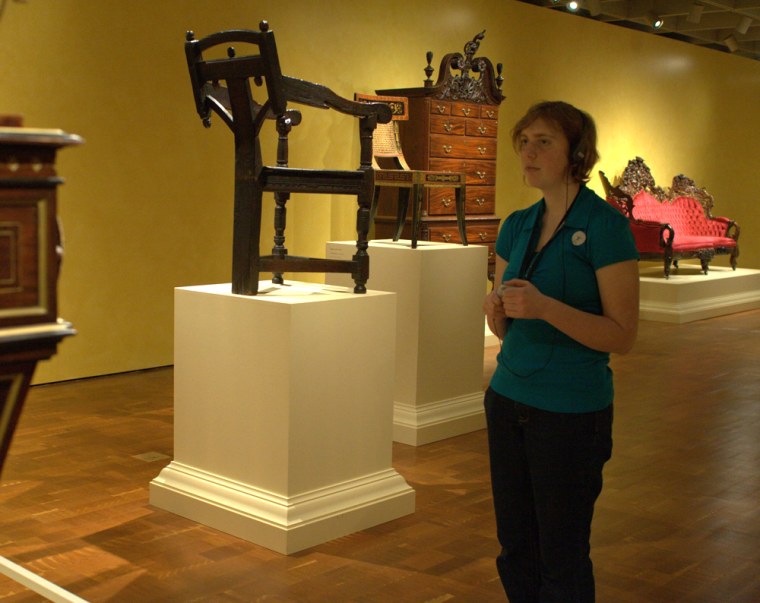Milwaukee Art Museum visitors can hear about American furniture from the 18th and 19th century, and music from those periods in the new iPod Touch tour.
At The Baltimore Museum of Art, people can stand at a touch-sensitive flat screen for a virtual tour of the apartment and artwork of sisters Claribel and Etta Cone, who assembled a grand collection of pieces from Henri Matisse, Pablo Picasso and Vincent van Gogh.
At the Brooklyn Museum, two laptops with Web cams record videos of people talking about race in relation to the exhibition "The Black List Project" to be broadcast on YouTube.
These aren't the experiences your grandparents, or even parents, had at museums. Art museums nationwide are trying to connect in different ways to a population spending more time on Wiis and getting information from the touch of a button on smart phones.
"The goal here is not to have technology replace the real experience of the art in the museum, but technology becomes an important point of access," said Milwaukee Art Museum Director Dan Keegan. "Technology becomes a critical educational tool. Technology becomes a social connecting link for people who are like minded."
The museum is one of a growing number gravitating toward using MP3 player and iPod tours and incorporating other technology, said Ford Bell, president of American Association of Museums.
Keegan said the museum has received positive comments since it started the iPod pilot program in October. It has five iPods featuring music and opera singer Christian Elser talking about pieces. He wants to get at least 200 iPods and add better wiring for cell phone and Wi-Fi reception so visitors can access tours and information through cell phones. The goal is to have at least one sound bite for every piece on display.
"We won't think of hanging a work of art without a label and at least the audio clip," he said.
But he said interested sponsors are holding off because of the economic downturn. He was optimistic the museum will eventually get the funding.
Museum officials also want to install a photo portrait booth where people can choose their photo style among painter styles, Keegan said. He also eventually wants to use GPS technology to help guide people through the museum.
Maxwell L. Anderson, director of the Indianapolis Museum of Art and past president of the Association of Art Museum Directors, said most of the association's 190 members concentrate on e-mail newsletters, Web sites and presence on social networking sites.
He said few are concentrating on iPods and cell phone guides and other technological gadgets and even fewer will start soon because of the economy.
The devices don't necessarily keep people coming in the door, he said.
"Whether it's cell phone or iPod or any other gizmo, the premise is what content is being delivered and how engaging that is and how sticky that content is in the hearts and minds of potential visitors," he said.
He said his museum has had cell phone tours for two years, but only a small percentage of people use it.
Maggie Weber, 15, of Waukesha, Wis., was at the Milwaukee Art Museum with her family recently and tried the iPod tour. Weber said she wouldn't go to the museum just because of the iPod but she would use it. She liked how the museum paired photos of the furniture with the music.
"It makes the museum more modern," she said.
Other examples of art museums using technology:
- Cell phone users at the Walker Arts Center in Minneapolis can call a special phone number and plug in a code to hear more information for about half of its pieces. It also has an interactive table system that people can drag works of art and human figures together to get more information about the artwork and artists. There's also the Dolphin Oracle, which allows visitors to type a question about an artist or piece and get an answer. The table and the dolphin were designed by local artists. "I think there's often a big kind of gap between how much information you can put on the wall next to a piece," said Justin Heideman, one of the museum's new media designers.
- At the Brooklyn Museum, iPod Touches were mounted last fall on walls next to seven pieces in the "Burning Down the House: Building a Feminist Art Collection" exhibition. It features video of artists speaking about the work.
- The Baltimore museum also uses the 3D screens for visitors to see a Matisse sculpture from different angles and light, as well as how Matisse may have created it.
- The Museum of Modern Art in New York City has free Wi-Fi so people can access audio tours through their iPod Touches and iPhones or any MP3 players.
- Many museums are revamping their Web sites to make them more interactive and using social networking sites such as Twitter and Facebook. The new secretary of the Smithsonian Institution is digitizing its more than 136 million objects in its 19 museums.
